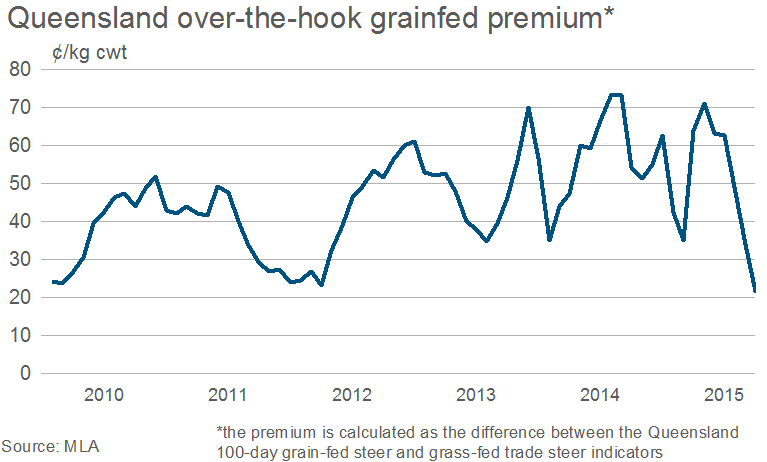Grass-fed and grain-fed cattle indicators align
As quality finished grass-fed cattle become increasingly difficult to source in Queensland, the premium of grain-fed cattle has been eroded.
While both the grass-fed and grain-fed Queensland over-the-hook indicators have shown strong growth in recent weeks, as illustrated in Figure 1, grass-fed prices have outstripped those of grain-fed.
In fact, a number of south-east Queensland processor grids now have little (5¢/kg cwt) to no premiums for grain-fed cattle over equivalent grass-fed lines.
Across Queensland this week:
- Heavy grass-fed yearling steers averaged 557¢/kg, up 13¢/kg cwt
- Heavy 100 day grain-fed steers averaged 563¢/kg, up 9¢/kg cwt
- Heavy MSA grass-fed yearling steers averaged 583¢/kg, up 13¢/kg cwt
- Heavy MSA 100 day grain-fed steers averaged 585¢/kg, up 13¢/kg cwt
All prices quoted above are for 300-320kg cwt, 0-2 tooth, A-C muscle steers.
However, it is important to note that while the top grass-fed over-the-hook indicator is close to the equivalent grain-fed indicator, very few grass-fed cattle would be able to meet this specification.
Figure 1, below, illustrates the strong increase in the Queensland grass-fed trade steer indicator (240-260kg, 0-2, tooth, A-C muscle) and the 100-day grain-fed steer indicator (300-320kg, 0-2, tooth, A-C muscle) so far this year. Figure 2 illustrates the difference between the two price series.

The last time the grain-fed premium was as narrow as it is now was in 2011-12, when low grain prices eased the pressure on grain-fed cattle prices and favourable seasonal conditions saw grass-fed cattle slaughter slow, lifting prices.

It is not surprising that the premium for grain-fed cattle has been eroded. According to the Queensland Government Science Delivery Division of the Department of Science, Information Technology and Innovation (DSITI), the majority of Queensland, in particular the central and western regions, has had below-average to extremely-low pasture growth over the past six months, making it increasingly difficult to find cattle in good condition off grass. Meanwhile, grain-fed cattle supplies have been at record levels this year, with the ALFA/MLA June quarter feedlot survey indicating there were close to 957,000 head in Australian feedlots.
The MLA OTH indicators are calculated as a slaughter-weighted average of processor grids. Prices are collected from processors which represent the majority of cattle killed in each state. Prices do vary within categories and the OTH indicators do not represent all discounts of cattle failing to meet processor specifications. Hence, quoted OTH prices should be viewed as indicators and individual vendor prices received may vary.
Click here to access all MLA OTH indicator and slaughter reports



